
By six weeks puppies need much more room than they do at five weeks. It has been proven to work best to have the potty area farthest away from where you greet the puppies.
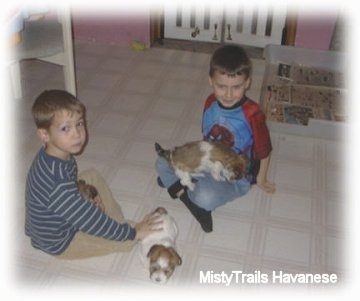
This picture shows the box I use for an indoor puppy potty station. It is located far from bed and food, by the door that is used to go outside. You can see on that door the bells that are hanging; some owners like to use the bell system for the older dogs to ask to go outside. They soon learn if they ring the bells, the door gets opened.
These puppies are too young to learn this, but do use the box. (Potty station box is a Rubbermaid under mattress storage box with short sides. It is easy to clean.)
I do not recommend puppy parents to use this system unless the puppy is an apartment dog and will continue to use a potty station. It is recommended that when you first get your puppy at 8 weeks or older, you immediately begin the type of potty training that will be routine, i.e. outside. All dogs prefer to go outside.
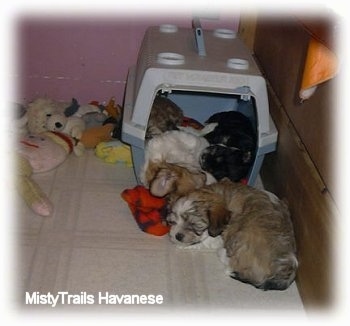
At five to seven weeks, putting a crate in the pen like one they will be using at their new home is recommended. They do not see this new den as a scary thing, in fact they stuff themselves into it. >>>>>>Doggy Pile<<<<<<< All dogs learn to love their crates as their dens. See article about crate training

Pen designed for the Misty Method of housebreaking very young puppies.
Using the Misty Method, at seven weeks, the play area has been expanded to its maximum size as they are really playful now, and need room to run, romp and roll.
Included in this box are enough toys for each to take one home. It will smell very nice and familiar to them. They are also being introduced to crates.
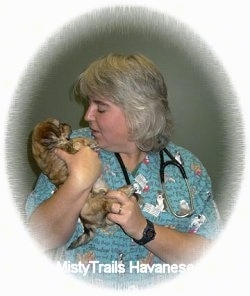
A seven and a half-week-old puppy with the vet.
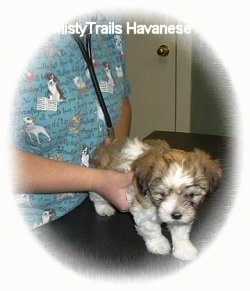
Seven and a half-week-old puppies at the vet.
At six weeks pups are NOT yet ready to have their first set of booster shots. I like to wait till they are seven or eight weeks old. Booster shots should be done a few days before the pup leaves for his/her new home, not on the same day. At this time the pups can also be tattooed and/or microchipped.
This will be their second visit to the vet; the first was at three days old for an exam and dew claw removal.
Remember, this first set of three booster shots ONLY protects the puppy for you to get this puppy home. New puppies should NEVER be socialized outside the family home or your own fenced-in yard (fenced, as you do not want strange dogs eliminating in your yard). The next set of shots is due four weeks after the first, and this puts minimal protection on the puppy, allowing you to socialize with friends’ dogs and homes that you know 100% have been vaccinated and are healthy. The last set of boosters, including rabies, is done in another four weeks. Your puppy is now protected, and is able to go to the park, where unknown dogs have been. At seven weeks, puppies can be taught small training skills, and they are also able to start to recognize their name.
Seven-week-old puppies are still too young to ship as cargo. I rarely ship via cargo, but if this is the only way, nine weeks would be the very youngest.
Vet shopping: If you do not have a vet you have a good relationship with, shop for a new vet. I recommend that if you are not totally convinced by the second set of shots that this is the vet for you and your new companion, then try a different vet for the third set of shots. I love my vet (there are six at the clinic), and they LOVE my dogs and puppies as their own.

Puppy getting examined by the vet, Salida's Sofialida of MistyTrails, Owned by Johanna and Usher
7.5 Weeks
Litter of Havanese Puppies being housetrained using the Misty Method
Poop station with the divider removed for cleaning. The divider also stops the pups from having JUST THEIR FRONT feet on the paper and peeing four inches back on the linoleum floor. Breeders that use the Misty Method have their puppies well on their way to being housetrained before they leave the breeder.
Seven puppies in this litter and they are all using the poop station. All of them. They are already on their way to being housebroken and they have not even left the breeder’s home. There needs to be a divider between the poop station and the play area because puppies run and play and roll and drag and chew the paper. The divider, even if it's a small one, HOLDS the paper down and in place. The picture shown above has the divider removed for cleaning. When they are playing, it kind of sections it off and stops them from running into the potty area to play—they just don't. They play in the clean area, and even excited they will sometimes run on the paper, but not as much. The wood is awesome, but doesn't need to go full length and it does not need a door.
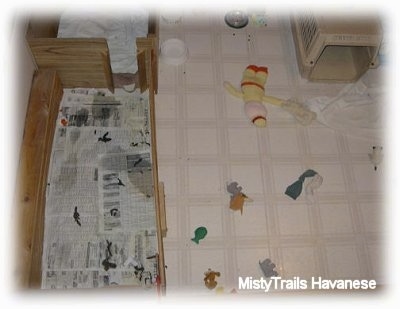
This is a shot of the pups’ area in the morning. This litter is exceptionally trained at seven and a half weeks of age. ALL have gone pee and poop on the paper station area during the night; their play area is clean. I usually find an accident or two each morning, but the last couple nights have been accident free. When they have to go, they stop what they are doing and run through the door to the paper. None of the pups are in this picture, as they are running free in the kitchen. They are almost ready to go to their new homes and ready for some individual training. This IS a LOVELY bunch of smart puppies. This litter has been cared for and raised properly. They know at such a young age that there is a designated spot to do business, and that is not in bed, or the play area, and not all over the house.
When you do not have a separate place for the pups to poop, they just poop where they play, and then roll and play in it.... AHHHHHH...And when you try to clean it up they mob you and the pile of poop. The dog door works awesome. I can lock them on either side while I clean up mistakes, or change the paper or bedding. The door can be closed.
Tips on paper-training a litter of pups...which make housetraining much easier. Pre-housetraining should be part of the process in housetraining a dog. One of the leading causes for dog neglect, and the dog becoming a fixture in the backyard, is from poor house habits. It is a well-known fact that no one wants a dog that hasn't learned to eliminate outside or in a designated indoor potty station, wandering loose in the house. It is also the most enjoyable relationship to have your dog involved in everyday family activities. This IS why you got the dog in the first place, isn't it??? No one wants a dog that hasn't learned to eliminate outside or in a designated spot in the house.
Do not raise the puppies in one big box or put the paper in a corner; the pups will just drag the paper everywhere and play with it. With experience, I have learned sectioned rooms work best. That is how a house is... bedroom or crate, play living area, a place to eat, and a door to go outside. Even outside, dogs create a place to eliminate and usually go to that area repeatedly.
Do not change the paper too often in the beginning, as you are creating the odor of an elimination spot to trigger instinct. I advise covering poop and pee with a layer of paper during the day and cleaning up each morning, leaving one piece of paper with pee smell. You cannot keep too clean, as when young the smell is what draws them to that area If you leave the paper soiled, they will also find another place to go... So you have to find a happy medium, which is clean, but smelling like a bathroom. By seven weeks, you can change the paper as often as you like, as it isn't the smell that is drawing them; they have learned that is the designated area to eliminate.
Removable wood divider used in the Misty Method of housetraining very young puppies
A wooden removable divider used for penning off the puppies in different areas.
At night it is open as they walk over and potty and go back to bed. But in the day when they are active, I put up a divider, mainly to HOLD the paper where it is or else they will drag it. This stops them from playing and skidding into a land mine (poop). ;-)
Here is the room in the morning. The wood was in place in the night.
This wood does one more thing: puppies will go to the paper and stand with their front paws on the paper and back end off, and will pee all over the floor, four inches from the paper.
The wood encourages them to go INTO the potty area.
This one area is all clean, ready for them to come out into the playroom in the morning.
They have the 10 x 10 room at night.
In the morning they come out to the playroom and use the doggy door to a big deck that is approximately 6’ x 20’.
On the deck, notice the potty station in the background. The outdoor potty station is the adult station. It is paper, under a rack, as...you know, when one dog goes out to pee, the rest MUST follow and pee too. Then you have a flood puddle of pee, and they all step in it. So, pee gravel is what I have in the other runs. However, if they are in the house and need to get out, they can get to the deck where there is the paper under a rack. So five dogs can pee, and none will get their feet wet and track it back into the house.
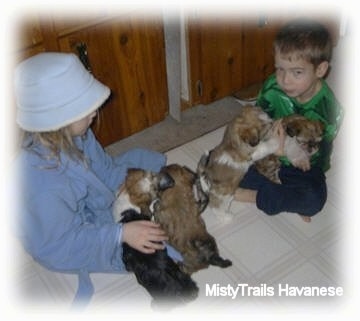
Pups playing with the kids in the morning
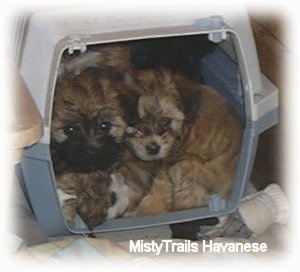
The pups all decide to take a nap in the small crate inside their area.
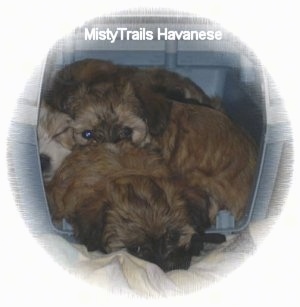
Giving them a crate to crawl into is an excellent way to make the trip to their new homes less stressful.
Upon bringing your puppy home, housetraining should begin immediately. A dog needs to be housebroken before you give him the run of your home. TEACH your dog by habit, not by hitting, that there is a spot for everything—a place to eat, a place to sleep and a place to eliminate; exactly what he already hopefully has started to learn as a pup living with the breeder. And as the owner, you can train your dog to eliminate in a place of your choice. Just remember when choosing this spot that it will become permanent.
See article on crate training for more tips.
Courtesy of MistyTrails Havanese